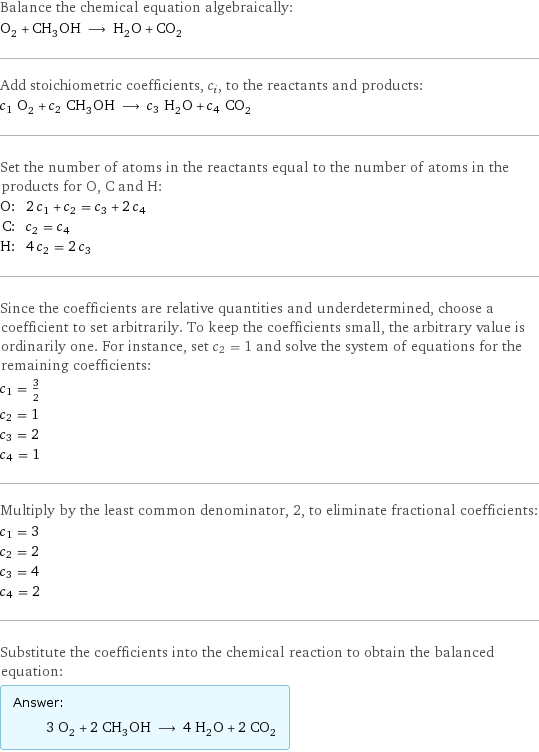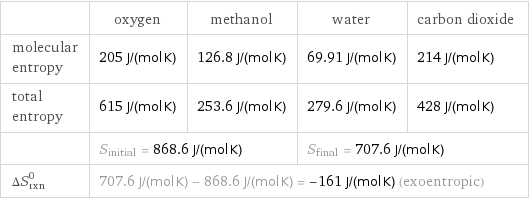Input interpretation

O_2 (oxygen) + CH_3OH (methanol) ⟶ H_2O (water) + CO_2 (carbon dioxide)
Balanced equation

Balance the chemical equation algebraically: O_2 + CH_3OH ⟶ H_2O + CO_2 Add stoichiometric coefficients, c_i, to the reactants and products: c_1 O_2 + c_2 CH_3OH ⟶ c_3 H_2O + c_4 CO_2 Set the number of atoms in the reactants equal to the number of atoms in the products for O, C and H: O: | 2 c_1 + c_2 = c_3 + 2 c_4 C: | c_2 = c_4 H: | 4 c_2 = 2 c_3 Since the coefficients are relative quantities and underdetermined, choose a coefficient to set arbitrarily. To keep the coefficients small, the arbitrary value is ordinarily one. For instance, set c_2 = 1 and solve the system of equations for the remaining coefficients: c_1 = 3/2 c_2 = 1 c_3 = 2 c_4 = 1 Multiply by the least common denominator, 2, to eliminate fractional coefficients: c_1 = 3 c_2 = 2 c_3 = 4 c_4 = 2 Substitute the coefficients into the chemical reaction to obtain the balanced equation: Answer: | | 3 O_2 + 2 CH_3OH ⟶ 4 H_2O + 2 CO_2
Structures

+ ⟶ +
Names

oxygen + methanol ⟶ water + carbon dioxide
Reaction thermodynamics
Enthalpy

| oxygen | methanol | water | carbon dioxide molecular enthalpy | 0 kJ/mol | -238.7 kJ/mol | -285.8 kJ/mol | -393.5 kJ/mol total enthalpy | 0 kJ/mol | -477.3 kJ/mol | -1143 kJ/mol | -787 kJ/mol | H_initial = -477.3 kJ/mol | | H_final = -1930 kJ/mol | ΔH_rxn^0 | -1930 kJ/mol - -477.3 kJ/mol = -1453 kJ/mol (exothermic) | | |
Gibbs free energy

| oxygen | methanol | water | carbon dioxide molecular free energy | 231.7 kJ/mol | -166.3 kJ/mol | -237.1 kJ/mol | -394.4 kJ/mol total free energy | 695.1 kJ/mol | -332.5 kJ/mol | -948.4 kJ/mol | -788.8 kJ/mol | G_initial = 362.6 kJ/mol | | G_final = -1737 kJ/mol | ΔG_rxn^0 | -1737 kJ/mol - 362.6 kJ/mol = -2100 kJ/mol (exergonic) | | |
Entropy

| oxygen | methanol | water | carbon dioxide molecular entropy | 205 J/(mol K) | 126.8 J/(mol K) | 69.91 J/(mol K) | 214 J/(mol K) total entropy | 615 J/(mol K) | 253.6 J/(mol K) | 279.6 J/(mol K) | 428 J/(mol K) | S_initial = 868.6 J/(mol K) | | S_final = 707.6 J/(mol K) | ΔS_rxn^0 | 707.6 J/(mol K) - 868.6 J/(mol K) = -161 J/(mol K) (exoentropic) | | |
Equilibrium constant
![Construct the equilibrium constant, K, expression for: O_2 + CH_3OH ⟶ H_2O + CO_2 Plan: • Balance the chemical equation. • Determine the stoichiometric numbers. • Assemble the activity expression for each chemical species. • Use the activity expressions to build the equilibrium constant expression. Write the balanced chemical equation: 3 O_2 + 2 CH_3OH ⟶ 4 H_2O + 2 CO_2 Assign stoichiometric numbers, ν_i, using the stoichiometric coefficients, c_i, from the balanced chemical equation in the following manner: ν_i = -c_i for reactants and ν_i = c_i for products: chemical species | c_i | ν_i O_2 | 3 | -3 CH_3OH | 2 | -2 H_2O | 4 | 4 CO_2 | 2 | 2 Assemble the activity expressions accounting for the state of matter and ν_i: chemical species | c_i | ν_i | activity expression O_2 | 3 | -3 | ([O2])^(-3) CH_3OH | 2 | -2 | ([CH3OH])^(-2) H_2O | 4 | 4 | ([H2O])^4 CO_2 | 2 | 2 | ([CO2])^2 The equilibrium constant symbol in the concentration basis is: K_c Mulitply the activity expressions to arrive at the K_c expression: Answer: | | K_c = ([O2])^(-3) ([CH3OH])^(-2) ([H2O])^4 ([CO2])^2 = (([H2O])^4 ([CO2])^2)/(([O2])^3 ([CH3OH])^2)](../image_source/7b6e746de08698a40d89428506f5eebc.png)
Construct the equilibrium constant, K, expression for: O_2 + CH_3OH ⟶ H_2O + CO_2 Plan: • Balance the chemical equation. • Determine the stoichiometric numbers. • Assemble the activity expression for each chemical species. • Use the activity expressions to build the equilibrium constant expression. Write the balanced chemical equation: 3 O_2 + 2 CH_3OH ⟶ 4 H_2O + 2 CO_2 Assign stoichiometric numbers, ν_i, using the stoichiometric coefficients, c_i, from the balanced chemical equation in the following manner: ν_i = -c_i for reactants and ν_i = c_i for products: chemical species | c_i | ν_i O_2 | 3 | -3 CH_3OH | 2 | -2 H_2O | 4 | 4 CO_2 | 2 | 2 Assemble the activity expressions accounting for the state of matter and ν_i: chemical species | c_i | ν_i | activity expression O_2 | 3 | -3 | ([O2])^(-3) CH_3OH | 2 | -2 | ([CH3OH])^(-2) H_2O | 4 | 4 | ([H2O])^4 CO_2 | 2 | 2 | ([CO2])^2 The equilibrium constant symbol in the concentration basis is: K_c Mulitply the activity expressions to arrive at the K_c expression: Answer: | | K_c = ([O2])^(-3) ([CH3OH])^(-2) ([H2O])^4 ([CO2])^2 = (([H2O])^4 ([CO2])^2)/(([O2])^3 ([CH3OH])^2)
Rate of reaction
![Construct the rate of reaction expression for: O_2 + CH_3OH ⟶ H_2O + CO_2 Plan: • Balance the chemical equation. • Determine the stoichiometric numbers. • Assemble the rate term for each chemical species. • Write the rate of reaction expression. Write the balanced chemical equation: 3 O_2 + 2 CH_3OH ⟶ 4 H_2O + 2 CO_2 Assign stoichiometric numbers, ν_i, using the stoichiometric coefficients, c_i, from the balanced chemical equation in the following manner: ν_i = -c_i for reactants and ν_i = c_i for products: chemical species | c_i | ν_i O_2 | 3 | -3 CH_3OH | 2 | -2 H_2O | 4 | 4 CO_2 | 2 | 2 The rate term for each chemical species, B_i, is 1/ν_i(Δ[B_i])/(Δt) where [B_i] is the amount concentration and t is time: chemical species | c_i | ν_i | rate term O_2 | 3 | -3 | -1/3 (Δ[O2])/(Δt) CH_3OH | 2 | -2 | -1/2 (Δ[CH3OH])/(Δt) H_2O | 4 | 4 | 1/4 (Δ[H2O])/(Δt) CO_2 | 2 | 2 | 1/2 (Δ[CO2])/(Δt) (for infinitesimal rate of change, replace Δ with d) Set the rate terms equal to each other to arrive at the rate expression: Answer: | | rate = -1/3 (Δ[O2])/(Δt) = -1/2 (Δ[CH3OH])/(Δt) = 1/4 (Δ[H2O])/(Δt) = 1/2 (Δ[CO2])/(Δt) (assuming constant volume and no accumulation of intermediates or side products)](../image_source/316b7af9b7bcb419d039a01e2aa28947.png)
Construct the rate of reaction expression for: O_2 + CH_3OH ⟶ H_2O + CO_2 Plan: • Balance the chemical equation. • Determine the stoichiometric numbers. • Assemble the rate term for each chemical species. • Write the rate of reaction expression. Write the balanced chemical equation: 3 O_2 + 2 CH_3OH ⟶ 4 H_2O + 2 CO_2 Assign stoichiometric numbers, ν_i, using the stoichiometric coefficients, c_i, from the balanced chemical equation in the following manner: ν_i = -c_i for reactants and ν_i = c_i for products: chemical species | c_i | ν_i O_2 | 3 | -3 CH_3OH | 2 | -2 H_2O | 4 | 4 CO_2 | 2 | 2 The rate term for each chemical species, B_i, is 1/ν_i(Δ[B_i])/(Δt) where [B_i] is the amount concentration and t is time: chemical species | c_i | ν_i | rate term O_2 | 3 | -3 | -1/3 (Δ[O2])/(Δt) CH_3OH | 2 | -2 | -1/2 (Δ[CH3OH])/(Δt) H_2O | 4 | 4 | 1/4 (Δ[H2O])/(Δt) CO_2 | 2 | 2 | 1/2 (Δ[CO2])/(Δt) (for infinitesimal rate of change, replace Δ with d) Set the rate terms equal to each other to arrive at the rate expression: Answer: | | rate = -1/3 (Δ[O2])/(Δt) = -1/2 (Δ[CH3OH])/(Δt) = 1/4 (Δ[H2O])/(Δt) = 1/2 (Δ[CO2])/(Δt) (assuming constant volume and no accumulation of intermediates or side products)
Chemical names and formulas

| oxygen | methanol | water | carbon dioxide formula | O_2 | CH_3OH | H_2O | CO_2 Hill formula | O_2 | CH_4O | H_2O | CO_2 name | oxygen | methanol | water | carbon dioxide IUPAC name | molecular oxygen | methanol | water | carbon dioxide